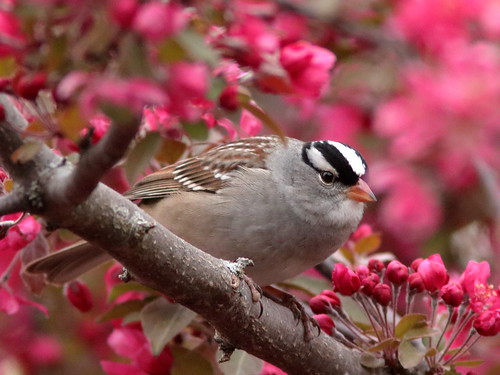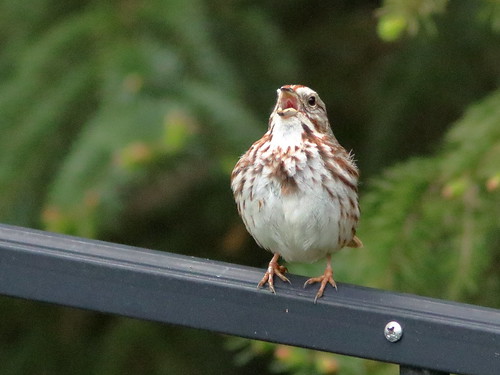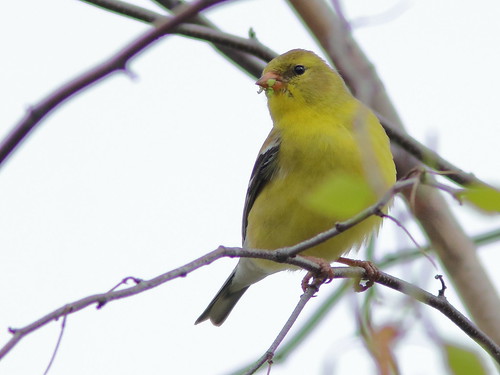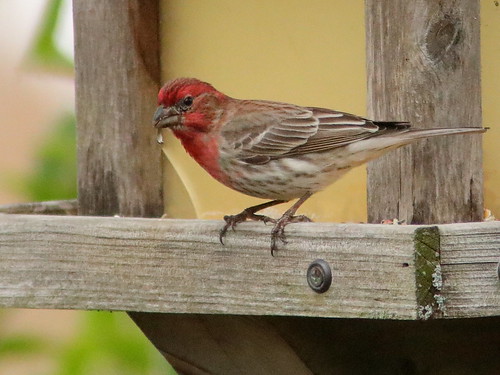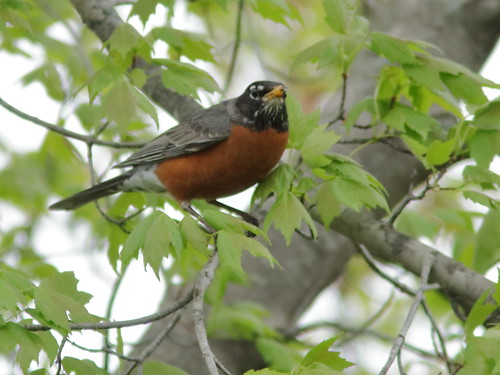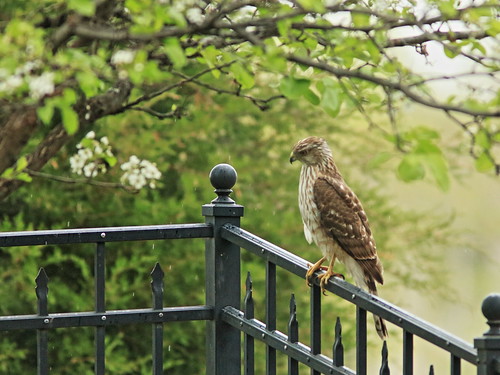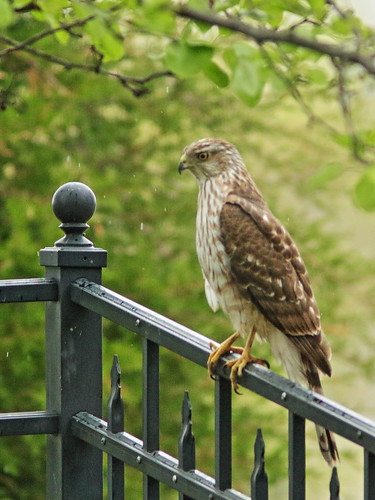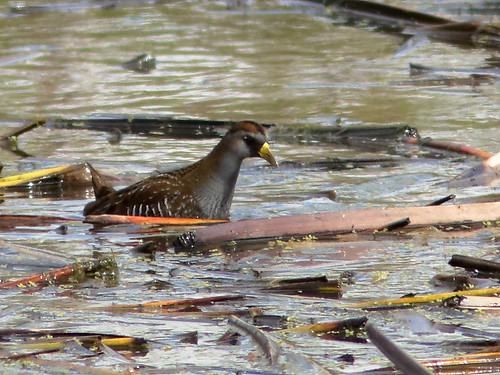I stumbled upon, or should I say I almost stepped on, the nest of a Common Nighthawk at about 8:30 AM on May 19. It was located very near the edge of the path along the side of the gravel road which leads into our local Wounded Wetlands.
The female alarmed me by suddenly flying up when I was only a few feet away from the nest. I froze in place and carefully looked around the spot from which she had erupted in flight. Sure enough, I found two eggs on the bare ground next to a small patch of weeds.
The female was very disturbed by my presence. She performed a distraction display about 10 feet away, flopping on the ground as if injured:

The eggs blended with the colors and textures of the surrounding terrain:
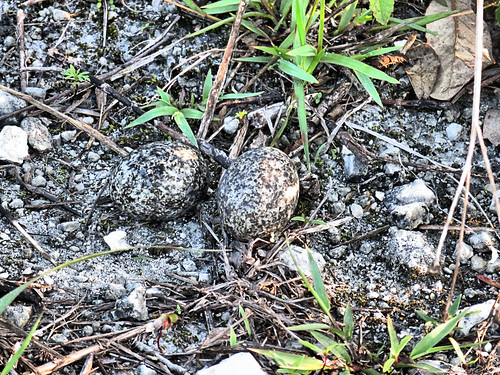
Indeed, I was lucky to find them as they are practically invisible when viewed from any distance. This is about how they looked when I found them. You probably can see them easily here, but if not, look closely at the upper left hand corner of this photo (1/3 down from top and from left edge of frame):
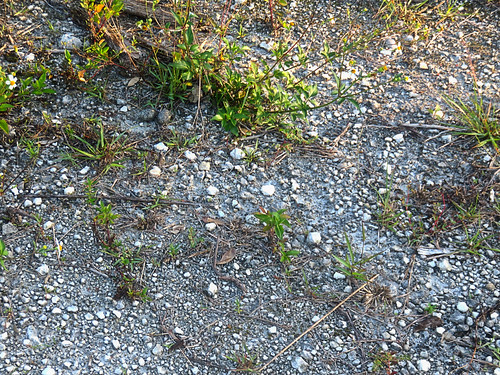
Stepping back, they are very difficult to locate. They are in the lower right quarter of this photo:

This photo shows how vulnerable the nest may be, as people walk their dogs along the path and predators such as Opossums, Raccoons, feral cats and Bobcats all prowl through the area (Arrow points to nest):

Since then I have photographed the nest every morning from a safe distance with my telescopic lens. Even though I know where to look, the incubating female is almost invisible:


The female sits on the eggs for 16 to 20 days while the male often flies overhead, swooping down and "booming" just over the heads of any passerby. Males have a bright white collar, lacking in the female, and have larger wing spots:


Both members of the pair feed the young, and often the female will start incubating a new batch of eggs while the male continues caring for the first brood.
Killdeers are also nesting along the gravel road. They, too, perform distraction displays to lead intruders away from the nest. Here are examples of one fanning its bright tail and acting as if seriously disabled:
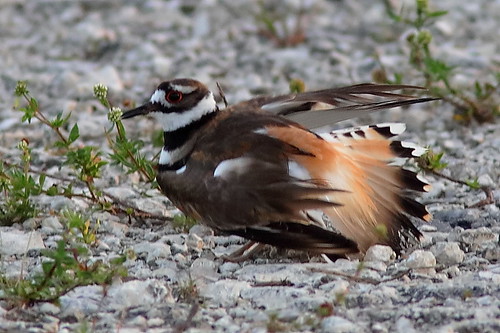

Again, I almost stepped on the Killdeer nest, as it was out in the open. The nest is merely a scrape which is surrounded by a ring of small pebbles which may continued to be added until the eggs hatch. It contained three eggs. The one in the foreground shows the normally darker rounded end which is facing the camera:

Indeed, the next day (May 27) I found another new egg, which I presumed to complete the normal clutch of four for this species. I expected them to soon be rearranged so that all the pointed ends face inward to provide for more efficient incubation:

Surprise! On the morning of May 29 I found yet another egg for a total of five. They must be incubated for 24 to 28 days, exposed to all the hazards which include joy-riding vandals on ATVs:

Out early, the lake provides nice reflections of the clear sky. A clump of Spatterdock (Yellow Pond Lily) floats on the surface:
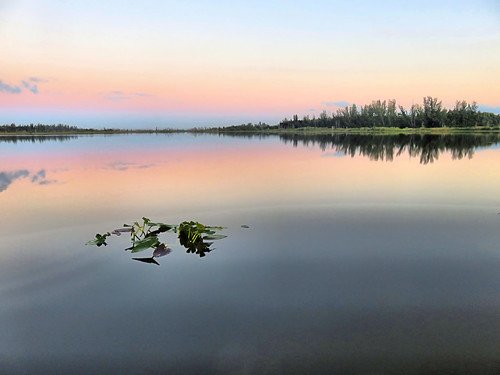
To the south, storm clouds build over the Florida Keys before sunrise:
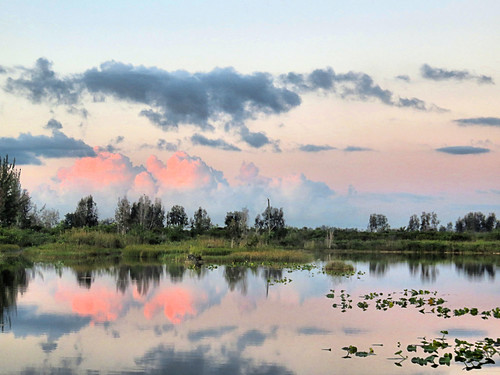
A Tricolored Heron hunts in the predawn twilight:
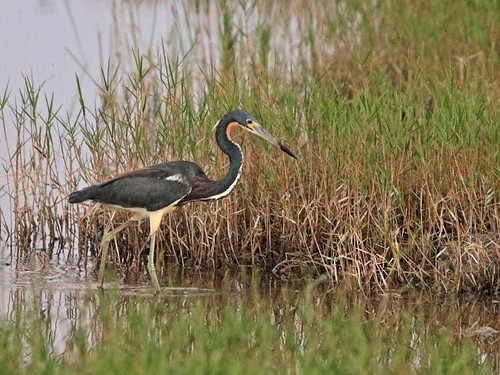
In our back yard, the mangoes are ripening:
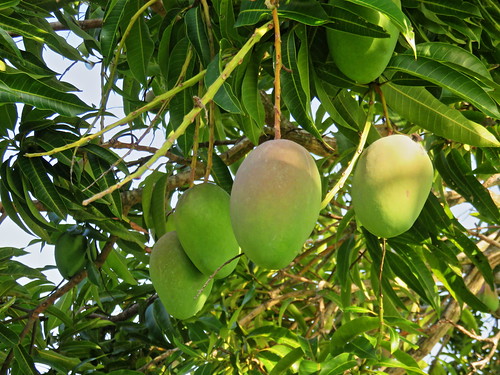 A note about observing nests-- While birds generally will not abandon a nest after brief disturbances, it is best to observe nesting birds from as great a distance as possible. This requires using binoculars or a long lens for photographs. If a bird is flushed from a nest with eggs, it is important to allow the bird to return as soon as possible. As seen in these photos, the disturbance causes great energy-depleting stress for the parent birds. Uncovered eggs are exposed to predation and the effects of extreme temperatures, particularly overheating by the sun which may kill a developing embryo or nestling. Predators also may be attracted to the nest by following your scent or observing your intrusion.
A note about observing nests-- While birds generally will not abandon a nest after brief disturbances, it is best to observe nesting birds from as great a distance as possible. This requires using binoculars or a long lens for photographs. If a bird is flushed from a nest with eggs, it is important to allow the bird to return as soon as possible. As seen in these photos, the disturbance causes great energy-depleting stress for the parent birds. Uncovered eggs are exposed to predation and the effects of extreme temperatures, particularly overheating by the sun which may kill a developing embryo or nestling. Predators also may be attracted to the nest by following your scent or observing your intrusion.
= = = = = = = = = = = = = = =
Linking to Misty's CAMERA CRITTERS,
Linking to Eileen's SATURDAY'S CRITTERS,
Linking to SKYWATCH FRIDAY by Yogi, Sylvia and Sandy
Linking to WEEKEND REFLECTIONS by James
Linking to BirdD'Pot by Anni
Linking to Our World Tuesday by Lady Fi
Linking to Wild Bird Wednesday by Stewart
Linking to Wordless Wednesday (on Tuesday) by NC Sue
Linking to ALL SEASONS by Jesh
________________________________________________
Please visit the links to all these memes to see some excellent photos on display
________________________________________________
We returned to NE Illinois for the second time this spring. Because of a flight cancellation we missed celebrating our daughter's birthday there, but MaryLou did take part in our granddaughter's Confirmation ceremony. Although our stay was brief and I was still fighting bronchitis, I made time to visit a few birding patches near our daughter's home.
While looking for sparrows in the last undeveloped plot in the Village of North Aurora, adjacent to Jones Meadow Park, I encountered a pair of Sandhill Cranes with two very young colts. They foraged among the yellow flowers in the pasture:


Young cranes are called "colts." The dictionary defines "colt" loosely to include, besides male horses and firearms, as "a young or inexperienced person." Although I could not trace the origin of its application to these birds, it is said to reference their long strong legs.
The colts stayed close to their parents as they moved along. Although the chicks are hatched with their eyes open and are active and capable of foraging on their own, their parents feed them or help them find food for the first week or two. Their diet consists mostly of seeds and other plant material, but they do prey upon insects and small vertebrates when encountered.
I witnessed an adult feeding an unidentified morsel to one of the colts:


Colts become competitive as they age, and parents are said to tend them separately to discourage fighting, but these little ones seemed to get along very well:
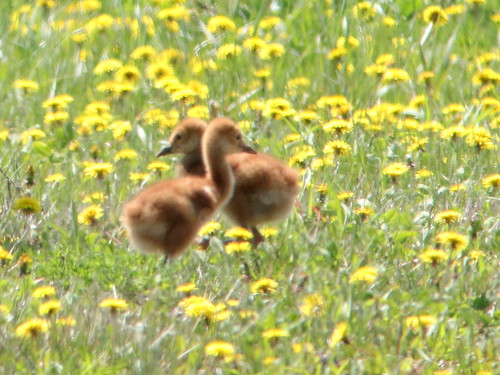

Working out of my laptop in Illinois, I have fallen behind in processing the photos, so here are a few from Florida during the days between trips.
A Northern Mockingbird persistently attacked a Fish Crow:
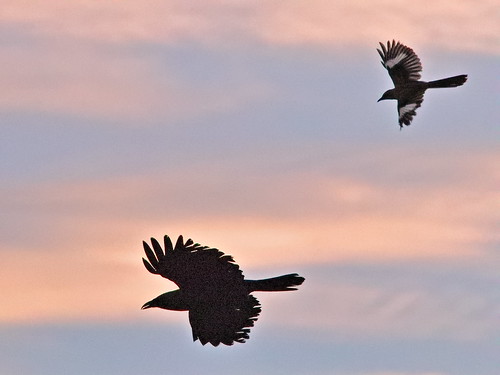
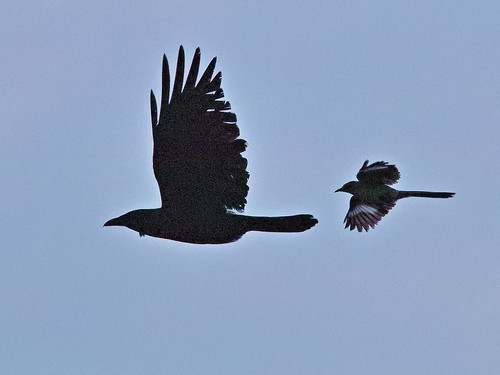
The Pine Bank reflected on still waters before sunrise on May 6:
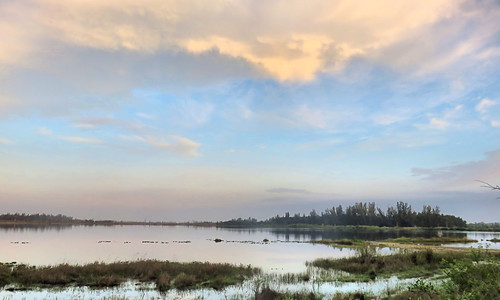 = = = = = = = = = = = = = = =
= = = = = = = = = = = = = = =
Linking to Misty's CAMERA CRITTERS,
Linking to Eileen's SATURDAY'S CRITTERS,
Linking to SKYWATCH FRIDAY by Yogi, Sylvia and Sandy
Linking to WEEKEND REFLECTIONS by James
Linking to BirdD'Pot by Anni
Linking to Our World Tuesday by Lady Fi
Linking to Wild Bird Wednesday by Stewart
Linking to Wordless Wednesday (on Tuesday) by NC Sue
Linking to ALL SEASONS by Jesh
________________________________________________
Please visit the links to all these memes to see some excellent photos on display
________________________________________________
It has been an eventful few days in our neighborhood Wounded Wetlands. Although spring migration has been slow, I added a (heard-only) Chuck-will's-widow to my patch list. A poor recording is my only documentation with no photos to share. It was quite near the trail about 40 minutes before sunrise. As has been the case with the Whip-poor-will, it stopped calling about a half hour before sunup.
An unusual visitor was this Black-whiskered Vireo. It was only my second sighting at this location, and one of only two recorded in Broward County so far this year.
I found the first one at almost this exact spot on April 20, 2011. Its namesake throat stripes are distinctive:
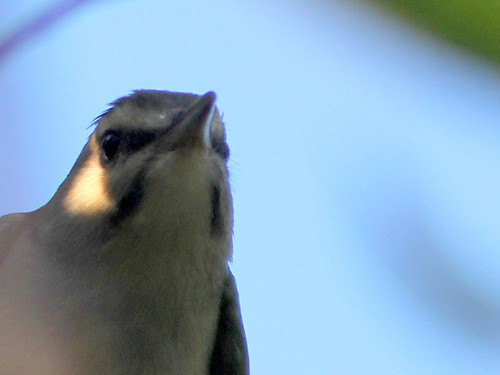
This time I got much better photos when, for a few seconds, it sat still out in the open after it ate Lantana berries (May 4, 2019):


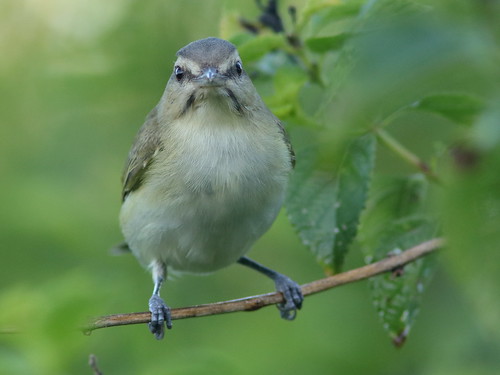
Black-whiskered Vireos breed in The Bahamas and Caribbean islands, but their US range is generally restricted to a migratory population in coastal mangroves of southern Florida. Their secretive habits make them hard to find as they glean for insects among the leaves. They are closely related to the similar Red-eyed Vireo. In fact, at first I misidentified it as the latter species. Close inspection reveals that, although its eyes have a reddish tint, it has a more massive bill and a duller brownish back:

Here is a Red-eyed Vireo for comparison (October 12, 2018):

Two different Bobcats showed up, only two days apart. The first was a small female which stared at me from the high grass on the left side of this trail:
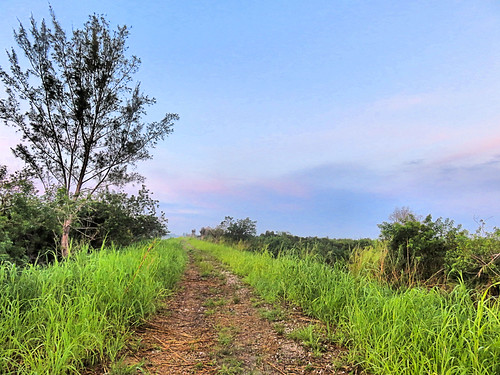
She jumped out and over the trail just as I raised my camera (May 3):

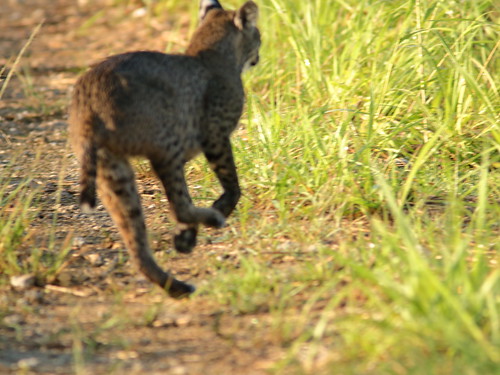
The other Bobcat was a large male, seen only about 100 yards away from where I saw the female. He walked leisurely across the gravel road (May 5):

He crouched down for a moment to check me out:

Male Bobcats usually occupy much larger territories than females. They seek out and mate with several but do not take part in rearing or defending the young. One of the local females appears to be quite pregnant (April 13, 2019):

We would expect her to avoid contact with the male and take such steps as covering feces and hiding in with her kits in a den. I can tell that a male is around when I find fresh Bobcat scat piles out in the open and close to each other, as this is one way they mark their territory.
A White-winged Dove peered out from the shadows (May 4):

Loggerhead Shrikes had disappeared for over two weeks, so I was happy when one posed in early morning sun on May 4:

That same day I saw my first Julia longwing of the spring season. They have been very scarce since Hurricane Irma ravaged the area almost two years ago. This is a fresh male:
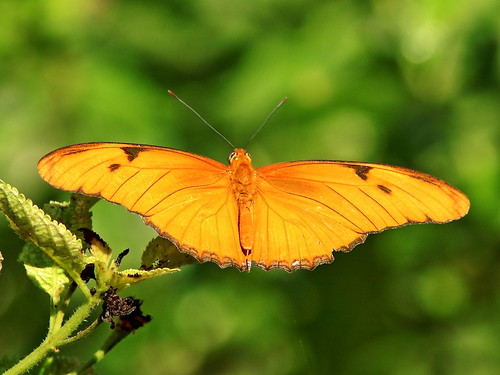
I had to get down on the ground to get a side view of a tiny but beautiful Dainty Sulphur:

We spent the week after Easter at Tranquility Bay resort on the Florida Keys. These are views from the beach at sunset (April 22-25):



 = = = = = = = = = = = = = = =
= = = = = = = = = = = = = = =
Linking to Misty's CAMERA CRITTERS,
Linking to Eileen's SATURDAY'S CRITTERS,
Linking to SKYWATCH FRIDAY by Yogi, Sylvia and Sandy
Linking to WEEKEND REFLECTIONS by James
Linking to BirdD'Pot by Anni
Linking to Our World Tuesday by Lady Fi
Linking to Wild Bird Wednesday by Stewart
Linking to Wordless Wednesday (on Tuesday) by NC Sue
Linking to ALL SEASONS by Jesh
________________________________________________
Please visit the links to all these memes to see some excellent photos on display
________________________________________________




















